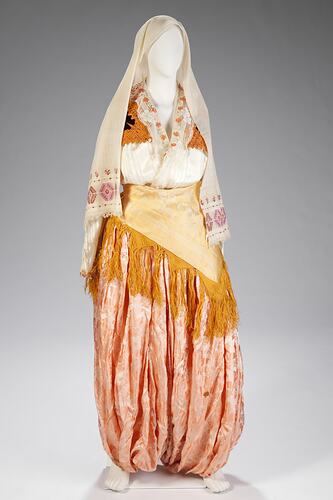Summary
Head scarf, which is part of a wedding ensemble from the Struge region in Albania. Part of a young Muslim Albanian woman's trousseau during the early 20th century. It was woven on a large silk weaving loom.
The woman (name unknown) was betrothed to be married but her fiancé died in tragic circumstances and the wedding did not proceed.
The young woman never married and the costume remained unworn until it was given by her family to Erik Lloga, a friend of the family, who migrated to Australia from Albania in 1969. The family were keen for him to 'save' the costume and the cultural traditions it represented, at a time when such traditions were under threat of survival in many eastern bloc states.
Physical Description
Long cream hand woven cotton head scarf with pin, blue, green, purple and yellow decorative border at each end and small fringe.
Significance
This wedding costume is a rare surviving example of its region. It also represents an active effort by one community to preserve its cultural traditions, both by transporting it to Australia where the costume had a chance to survive, and by making it accessible to the local Albanian migrant community. This costume demonstrates the disappearing silk weaving skills of Albanian women, and is a community act of acknowledgement of the important role women have played in the traditions of artistic production.
More Information
-
Collecting Areas
-
Acquisition Information
Donation from Mr Erik Lloga, 30 Sep 2008
-
Place & Date Made
-
User
Mr Erik Lloga, Coburg, Victoria, Australia, 1969
Erik brought the costume to Australia at the family's request. -
Classification
-
Category
-
Discipline
-
Type of item
-
Overall Dimensions
1550 mm (Length), 380 mm (Width)
-
References
Kurbet. The continuing journey of Albanians in Victoria, Immigration Museum Community Gallery room brochure, 2007-2008
-
Keywords
Albanian Communities, Albanian Immigration, Cultural Maintenance, Cultural Traditions, Glory Boxes, Muslim Customs, Silk Fabrics & Textiles, Weaving, Weddings
